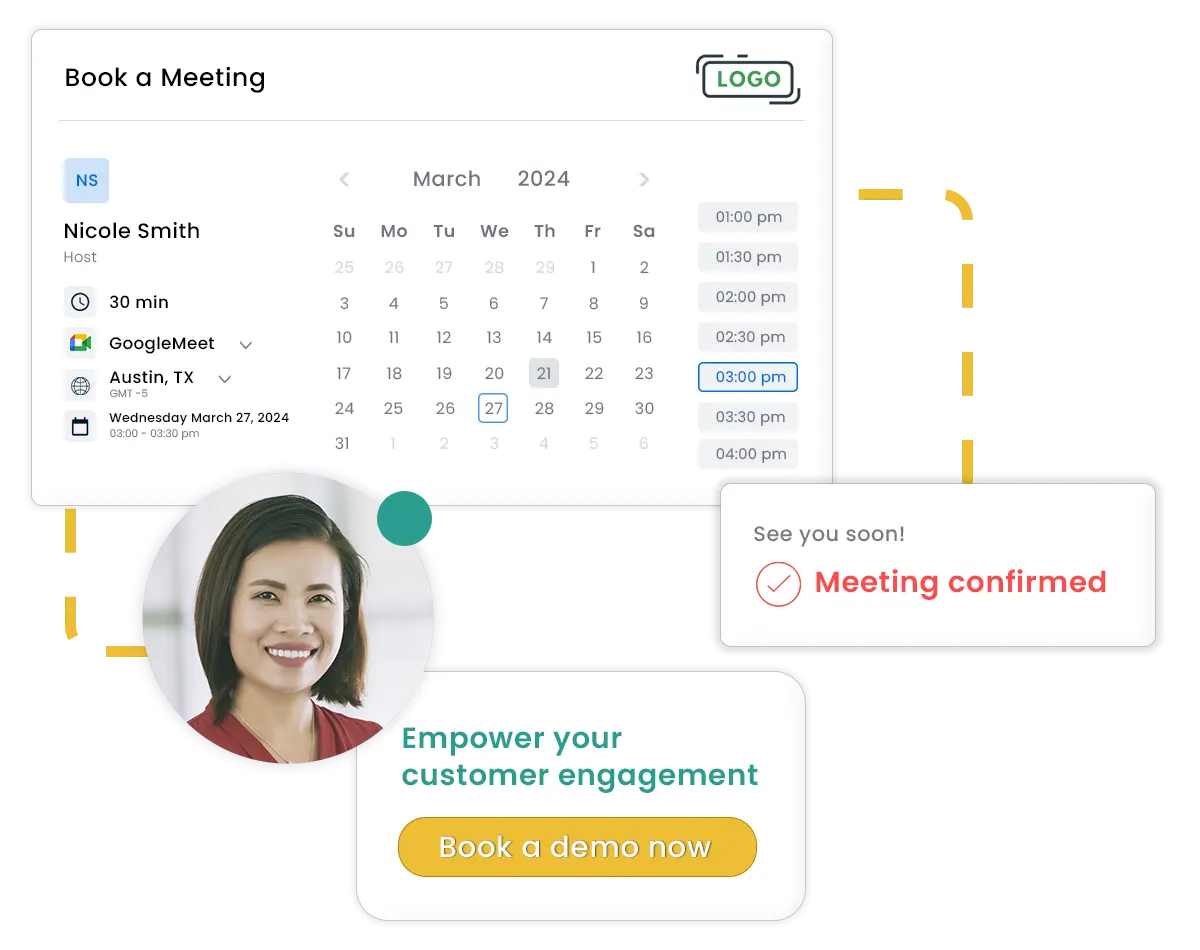AI isn’t about replacing people; it’s about removing the outdated friction in how we work. By handling repetitive tasks, AI lets sales and service teams to focus on what really matters: customer conversations. Learn how you can deliver faster, smarter customer engagement with AI.
This post breaks down the key types of AI powering customer experiences today, real-world examples of how companies use them, and ways you can apply them in your organization—from scheduling and support to follow-ups and personalization.
Key Takeaways
- AI helps businesses connect with customers. Not just faster but smarter. From booking appointments to resolving issues, AI speeds up interactions without making them feel corporate-face.
- By analyzing behavior, preferences, and timing, AI can tailor every touchpoint—from recommendations to follow-ups—at scale.
- AI doesn’t work alone—it integrates across your customer journey. Whether it’s AI chat, scheduling, or post-meeting follow-ups, the best results come when AI integrates in your workflows, CRM, and channels.
- SUMO’s AI Customer Engagement Platform turns everyday tasks into smooth, connected experiences. By handling scheduling, meeting notes, and smart follow-ups, SUMO helps teams stay focused on real conversations—while the AI does the heavy lifting.
What is an AI Customer Experience?
AI-powered customer experience means using tools like chatbots, virtual assistants, and machine learning to help customers solve problems or get answers faster in cases where human involvement isn’t necessary.
Instead of copy-paste replies, AI can understand what really matters to a customer at that moment and respond in a way that saves both their time and the company’s.
For instance, a chatbot can book your customer’s appointment in seconds, auto-matching their preferences with your availability, while it would take far more time and effort from both sides to agree on a time via email or phone. Instead, AI takes care of those routine intermediate steps to make customer interactions truly meaningful. Let’s see how.
5 Main Types of AI for Customer Engagement
If you’ve ever chatted with a bot, received a product suggestion that actually made sense, or got a follow-up email before you even thought to ask—chances are, AI was involved. Here’s what technology stands behind it:
AI Scheduling For Faster Connections
AI tools that handle appointment or meeting booking, often through conversational interfaces or forms, to connect customers with the right person at the right time. These systems blend machine learning, calendar integrations, and chat interfaces.
Use Cases:
- AI meeting assistants for Salesforce that book meetings based on prospect availability and CRM data
- AI self-service appointment booking with intent recognition
- AI agent for dynamic field service route and visit time optimization
Example: SUMO’s AI chatbot for appointment booking doesn’t just show the available slots but reads and responds based on the context. If your customer says, “I’m free to meet in the morning,” SUMO will suggest meeting slots based on time zone and location, taking into account the travel time.
Conversational AI For Human-Like Engagement
AI that enables two-way communication through text or voice. It mimics human conversation to guide people through tasks like booking appointments, answering questions, or resolving issues.
Use cases:
- AI chatbots (e.g., website support, FAQs)
- Voice assistants (e.g., smart IVRs, Alexa/Siri integrations)
- Live chat co-pilots (AI assists human reps in real time)
Natural Language Processing (NLP) For Creating The Context
NLP allows AI to read, understand, and generate human language in text. It comes as part of Conversational AI but can be used independently. e.g. to interpret and process meeting notes.
Use cases:
- Auto-generated replies in customer service
- Summarizing support tickets or conversations
Example: SUMO’s AI meeting note taker generates transcripts and meeting summary. The latter can be shared with customers to engage them better for further action. These notes are easily searchable through the users CRM and can be referenced to prepare for next step meetings or to ensure coordination.
Machine Learning (ML) for Personalization
AI that learns from data to spot patterns and make predictions. These systems tailor websites, emails, and messages for each person based on who they are, what they like, and how they’ve interacted before. Instead of copy-passed replies or bulk product suggestions, customer engagement actually feels personal.
Use cases:
- Predicting churn (which customers are likely to leave)
- Lead scoring (ranking prospects based on behavior)
- Personalized recommendations for product or content
Example: Salesforce Lead Scoring Tool can
Generative AI for Content & Followups
AI that writes customer responses, articles, or knowledge base updates. Generative AI models are trained on large language datasets and integrated with CRM or support tools to deliver contextually appropriate content. AI that creates new content based on prompts or data.
Use cases:
- Personalized email content
- Dynamic product descriptions
- Custom replies to customer inquiries
- Auto-generated knowledge base articles
In practice, these types of AI for customer engagement aren’t used in isolation. Instead, they complement one another — all tied together through APIs or CRM integrations to help businesses and customers solve their daily tasks and get practical value. Speaking of which.
Benefits of AI For Customer Engagement
AI can bring a lot of real, measurable benefits to how your business engages with customers. Let’s look at the key ways AI helps with some stats backing it up.
24/7 Service
AI neither sleeps nor takes shirts, no sick days, so customers can get help anytime. According to Gartner, by 2028, 70% of service interactions will start and finish within third-party virtual assistants.
Faster Responses
AI chatbots and assistants reply instantly, so your customers aren’t left waiting. IBM found that AI-powered chat can cut response times by 99%. That’s a huge jump in customer satisfaction.
Consistent Brand Interaction
Responding a hundred times to a very simple question can be frustrating for support agents — and why shouldn’t it be? We’re only human, after all, and we can’t be programmed to have just one emotion. But AI can, and for good.
Whether a customer reaches out on chat, email, or social media, AI can make sure the tone, speed, and quality of the interaction stay the same across the board. AI will never lose its temper but will be consistently willing to help your customers until they’re happy.
Personalize at Scale
Not just for your top customers, but for everyone. AI analyzes data and suggests the right message, product, or timing for each person. AI schedules reminders or follow-up messages at the right time, so customers feel remembered and valued.
Better Service Through Automation
AI frees up your time and effort for actual service. You can focus on solving specific customer pains instead of filling in the CRM, or spend more time with a patient instead of writing documentation.
With AI handling the basics, your team can focus on higher-value conversations or those where human touch is really needed — the tricky cases, the big deals, the people who need a thoughtful response.
Higher ROI Through Insights
AI can spot signs that a customer might leave or struggle and lets you reach out before they churn.
Self-Service Leads to Satisfied Customers
AI doesn’t just answer questions — it helps resolve issues faster. It pulls up order details or suggests solutions on the spot. That’s important, because Salesforce found that 30% of customers want AI to help resolve their issues more quickly.
So in short: faster responses, more personalized service, fewer dropped balls, and a team that gets to do more meaningful work. That’s the real value of AI in customer engagement.
Now, shall we see what that looks like in action? Let’s examine some of the best AI tools that you can apply in your business to increase customer engagement.
7 Ways AI Revisions Customer Engagement At Every Touchpoint

1. Schedule appointments with the perfect time for everyone
Booking a time to talk to someone shouldn’t feel like solving a puzzle. AI-powered scheduling tools now find the best times automatically, sync with calendars, and even adjust for time zones and availability across teams.
Example:
Bank of America uses AI-driven appointment scheduling to let customers quickly book time with specialists—whether for mortgages, investments, or account help. It saves time on both ends and makes walk-ins feel like VIPs.
Deliver that same VIP experience for your customers with SUMO’s AI-powered appointment management
2. Support customers 24/7 & actually help
We’ve all dealt with robotic bots that do more harm than good. But AI has come a long way. Today’s smart assistants can understand intent, escalate complex issues, and even learn from past interactions.
Example:
H&M uses AI chatbots across its global support channels to handle common questions, process returns, and suggest outfits—automatically switching between languages and even tones, depending on the customer.
3. Send follow-ups that drive action
After a purchase or a meeting, follow-up matters. AI now automates this—sending reminders, summarizing discussions, or suggesting next steps based on what was said.
Example:
Salesforce + SUMO AI note taker lets you automate follow-up emails based on your meeting notes. After a meeting is booked and held, AI scans the notes and drafts personalized emails for next steps right in your CRM — saving time and keeping the conversation moving.
4. Recommend what customers want
AI doesn’t just guess what customers want—it watches what they browse, buy, and abandon, then tailors suggestions in real time.
Example:
Sephora uses AI to personalize product recommendations based on past purchases, skin tone, and even beauty goals shared through a quiz. It’s like having a digital beauty advisor that remembers you.
5. Resolve issues before they escalate
Instead of waiting for complaints, AI can flag issues early—like noticing a drop in app usage, a pattern of delayed orders, or unusual payment activity—and prompt a follow-up before the customer even asks.
Example:
Spotify uses AI to monitor user behavior and jump in when it detects playback issues or unexpected errors—often offering personalized help or credits before the user submits a support ticket.
6. Guide customers on self-service, at their pace
Some people just want to solve things on their own. AI-powered help centers and virtual agents now make it easy by predicting what users are looking for and showing step-by-step help.
Example:
Zoom uses AI to power its helpdesk, guiding users through account setups, billing fixes, or troubleshooting—all without waiting for a human rep. The system learns what works and improves over time.Fast-track the cases that matter most
7. AI spots when a human needs to step in and gets the right agent on it.
Example: AI-driven dispatching systems, equipped with natural language processing and machine learning capabilities, can analyze and prioritize incoming emergency calls.
Make Every Customer Interaction Count with SUMO CEP
SUMO’s AI Customer Engagement Platform takes the hassle out of everyday tasks—like scheduling, follow-ups, and meeting prep—so your team can focus on what really matters: real conversations with real people.
Whether you’re in healthcare, finance, education, or retail, SUMO helps you turn each interaction into a thoughtful experience. Engage customers faster, smarter, and more personal—without adding to your team’s workload.
Ready to see it in action?
Learn how SUMO can simplify your customer engagement with AI.



